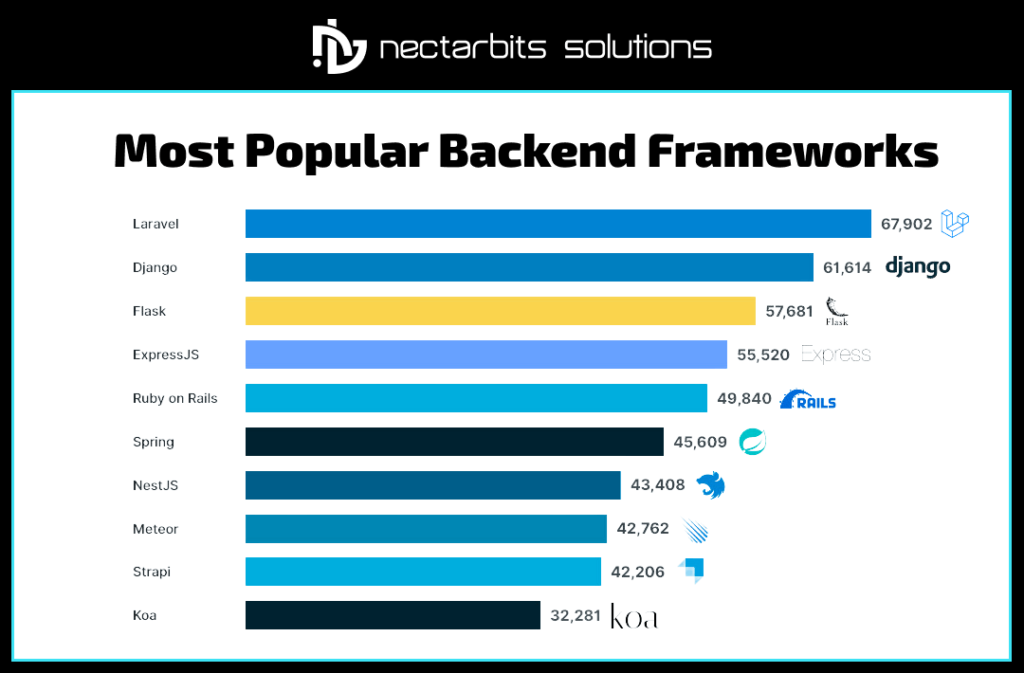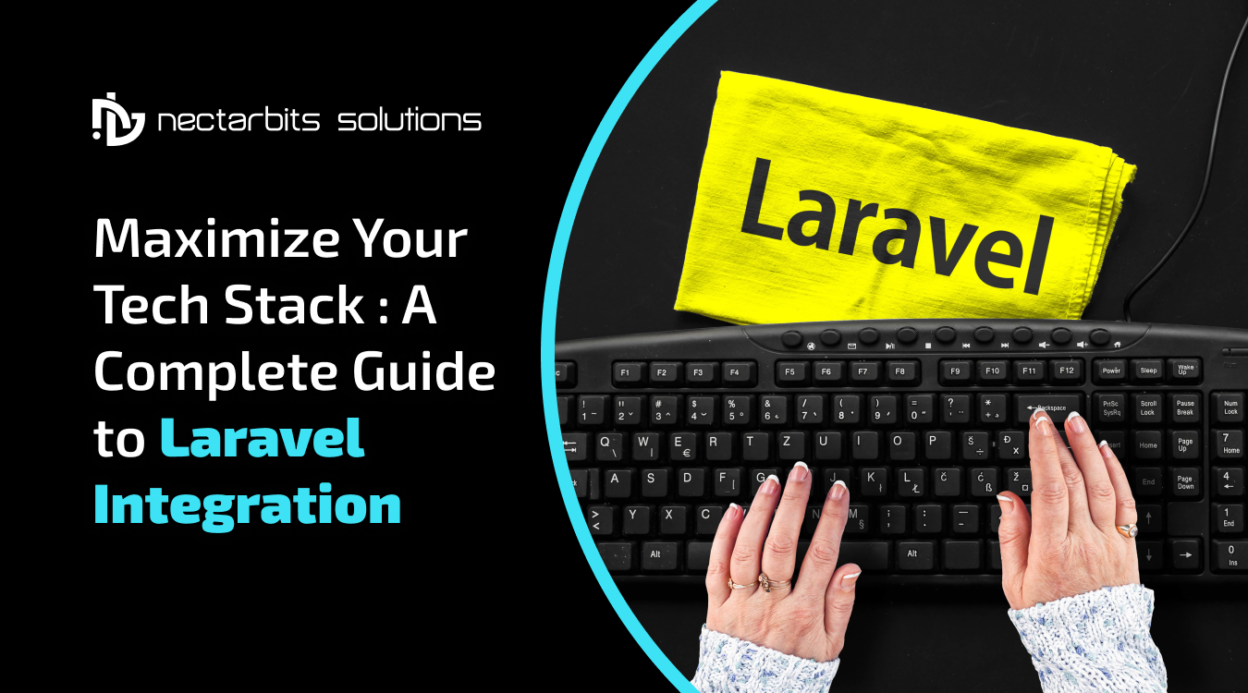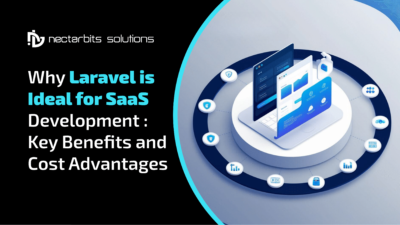As companies rapidly evolve their business needs to fit their digital requirements of app development and web development, the advancements in the digital age we currently live in have significantly affected the priorities of businesses. Now, creating a digital identity for a brand has become as important as its physical resources and products, and therefore, choosing the right tools to create the same is highly important to ensure the creation of an efficient and scalable digital identity.
This guide provides you with a deeper look into how you can utilize the marvelously adaptable and incredibly popular framework of Laravel web development services to boost your business’s app and web development. With an elegant syntax and an extensive toolkit, integrating Laravel with your existing systems can yield a better tech stack for your company that is both diverse and efficient. Laravel tech stack integration is thus a valuable addition to your current software framework, offering higher performance and cost efficiency.
Strategic Advantages of Laravel Integration
To integrate Laravel with the existing systems is not just the addition of a tool in your arsenal, but a strategic corporate decision that can potentially future-proof your digital identity. With its advanced modular architecture and a deep community-backed ecosystem, a Laravel tech stack integration can result in a slew of benefits for your company’s product visibility and user accessibility.
- Enhancing Flexibility and Scalability
One common issue that arises as the applications of various businesses develop is scalability. Laravel comes with the ability to be scaled out of the box: many of the system’s basic features are designed in such a way that developers can easily add more features to the system without destroying the existing ones. For example, Indeed , one of the biggest job search platforms, integrated Laravel web development services for the management of heavy backend processes which in turn unlocked a flexible scalability should the flow of users increase.
This way, with Laravel, they could modularize their application and not have to worry that an increase in size will affect speed. Laravel also has no shackles when it comes to microservices architecture which is in the process of becoming the new norm for any application. Through Laravel third-party API integration, multi-service interaction, and application, development cycle efficiency, and new functions’ release cycle can be improved significantly.
- Robust Security Features
Any web application must be secure more so for those business organizations that deal with sensitive information. Laravel has its share of several integrated security features that can be incorporated into your current system to improve the security infrastructure of your web application. For instance, Laravel integration comes with built-in CSRF protection and input validation, meaning that your application is not vulnerable to this.
Glassdoor is an example of a company that offered Laravel integration to perform security actions in its existing list of utilized technologies. This greatly minimized the likelihood of the abuse of the data, and in essence, it helped Glassdoor retain the confidence of users while dealing with an ever-expanding infusion of sensitive data.
Key Factors to Consider Before Laravel Integration

Laravel is the most popular backend framework, and while that is good news in terms of community support, it also means that it has a vast variety of tools and utilisations any new company needs to strategize upon before its utilization for its web or app development services. To achieve a successful integration of Laravel with the existing system, it is paramount that your business provides a strategic strategy with careful planning of each step required to achieve this daunting task. Here are some of the critical factors to keep in mind throughout the integration of the Laravel tech stack with your existing framework.
- Integration with Your Current System
Before adopting Laravel, you first need to consider how the current structure of Laravel interacts or integrates with other components in your system. Third-party access includes such components as databases, third-party APIs, and other types of backend facilities. Laravel’s Eloquent ORM can work with virtually any database out of the box, but the more you know about how your project is going to use the database, the easier it will be to integrate.
Laravel has a feature for API consumption, and if your current system is intensive with third-party API calls, Laravel provides efficiency in these tasks. For instance, an organization that is using different cloud service providers to store and process its data can use Laravel tools for Laravel third-party API integration to facilitate the proper working of the system as data moves from one facet to another. This can be facilitated by hiring outsourced Laravel developers and acquiring them on a flexible basis for the project.
- Performance and Resource Allocation
Using Laravel in the flow of integration has performance implications in an already established program. Before deploying Laravel to your current infrastructure, it is important to do a performance benchmark to know how Laravel will impact your current resources. For example, adding Laravel integration might require changes to your server stack or further optimization because of the changing load or data throughput.
Furthermore, having a team that is proficient in Laravel web development services and at the same time in your current tech stack is beneficial. Laravel’s learning curve is pretty small, but to integrate it, one should know its features and practices to the ground. Entities such as Glassdoor made it a point to familiarise their development departments with Laravel before integration with this framework and this was advantageous in that the process was as smooth as possible and the applications ran more efficiently.
Utilizing Laravel effectively requires any company to understand its versatility and adapt its current systems accordingly to enhance the efficiency of the Laravel tech stack integration. This includes the possibility of outsourcing this process and only paying for the initial development as your employees take care of its maintenance after the development. This can save you monetary resources without disrupting your current work culture or organizational hierarchy.
Read More:- How to Outsource Laravel Development: [A Complete Guide]
Step-by-Step Guide to Laravel Integration with your Tech Stack
1. Analyse your current architecture
It is recommended to start by carefully outlining all your in-house and/or third-party technologies, databases, services, and APIs. Since you will be wiring the Laravel integration into an existing system, understanding the current architecture will help you determine how best to do this, where to do this, and when to do this.
For instance, if your system is based on a monolithic structure, the Laravel integration may be done in such a manner that will slowly affect the shift to a microservices system. This can also work effectively in the decomposition of huge applications into smaller parts, each of which would be solved by Laravel, a factor that improves scalability and maintainability.
2. Setting Laravel in the Staging Environment
When the moment comes to integrate it fully, use Laravel web development service s i n the staging servers. It enables you to try out its compatibility with your current system as a live application is not affected. In this phase, it is possible to work with the arising problems and adjust Laravel to your system requirements.
This step is even more critical for highly frequented applications such as Indeed for which it proved to be highly essential. When testing the integration of Laravel in a sandbox environment, one can expose the application to the conditions commonly anticipated out there, to ensure that the integration and the custom software development solution will hold up to the expected traffic as desired.
3. Incremental Integration
If you do not want to change all the things in your current setting, the gradual Laravel integration and adaption method is the best solution for your company. One should begin using Laravel by applying it as tweaks to less important components of the application like authorization or content. This reduces the chances of interruptions, and your team gets a feel of Laravel before approaching more important parts.
For example, at the very beginning, Glassdoor used Laravel to process user authentication, which is a critical activity that is, however, sharply separated from the engine’s other actions. Once the team had some level of confidence in Laravel and how well it plays along, they extended the use across the application.

4. Optimize and Monitor Performance
After the integration of the application, the essential next step is the post-integration check. Laravel has features such as Laravel Telescope and caching systems which can be used to improve performance and find areas of application that may cause bottlenecks. To make Laravel integration effective you have to set key performance indicators (KPIs) so that you can be able to check the impact of integration.
For instance, Indeed used Laravel caching capabilities to lessen the amount of traffic on the servers and shorten the response time during periods of high traffic. This optimization was pivotal to providing a seamless experience to the end users, even as the platform outgrew millions of active users.
Laravel Integration Business Implications
The cost of Laravel integration tends to differ based on the extent to which your Laravel will be integrated and the number and nature of systems integrated.
- Development and Infrastructure Costs
Laravel web development services require the hiring of developers with experience in the operation, which is one of the main expenses of integration. The need for such services is great and senior developers may well request and get a better salary. Still, by investing in skilled developers it is possible to save over the long term on time to complete a development and enhance the application’s functionality while keeping track of your Laravel tech stack cost.
However, sometimes you might be required to improve the infrastructure to make Laravel integration costs work for you. This may require up-scaling your server resources or tuning for Laravel’s Eloquent ORM. Nonetheless, it is versatile when it comes to supported hosting environments, which allows using services like AWS or Azure, helping to find an affordable solution.
Indeed conducted a detailed analysis of their system and proved that the integration of Laravel into its existing system led to the diminution of the time required to develop new features by 15% in the large account, which in the long run led to higher cost savings.
- Ongoing Maintenance Costs
After the Laravel integration has been added, further updates and continuation of site compatibility and efficacy are needed. This comprises updating the system from time to time, fixing security holes, and auditing the performance. Albeit these costs are recurrent, there are lifelong plans that are essential for having a more flexible, secure, and efficient system.
Read More:- Why You Should Hire Expert Laravel Developers for Your Business
Conclusion: Future-Proofing Your Application with Laravel
Laravel integration into your existing tech stack is not just deciding on a new framework for your applications, but it is a wise decision that will help you prepare for the future and offer you multiple advantages such as scalability and security. Thus, having thought through the integration process, used the advanced tools of Laravel and constantly improving performance, you can guarantee that your application will meet the current and future requirements.
Like Indeed, and growing platforms like Glassdoor, Laravel is the framework of choice for today’s leading brands to manage the flexibility, security, and scalability needed in today’s fast-paced online ecology. Laravel integration, when done correctly, is capable of transitioning your current system into a far more dynamic and strong system, capable of giving you a winning chance in the growing challenges of a digitized future.
Frequently Asked Questions (FAQs)
1. What are the key benefits of integrating Laravel with an existing system?
Integrating Laravel with your existing system offers several strategic benefits:
- Laravel’s modular architecture allows your application to grow without compromising performance.
- Built-in features like CSRF protection and input validation enhance your system’s security.
- Laravel’s extensive toolkit reduces the time and resources needed for development.
2. How does Laravel handle third-party API integrations?
Laravel excels in third-party API integration, ensuring smooth data flow between different services:
- API Consumption: Laravel provides efficient tools for handling API calls.
- Seamless Interaction: It integrates well with various databases and cloud services, making data management easier.
- Performance Optimization: Laravel’s Eloquent ORM ensures efficient database interactions.
3. What should I consider before integrating Laravel into my current tech stack?
Before integrating Laravel, consider these factors:
- Ensure Laravel integrates well with your existing databases and services.
- Conduct a performance benchmark to understand resource implications.
- Ensure your team is skilled in Laravel to make the integration process smoother.
4. How does Laravel integration affect the overall cost of development?
Laravel integration can impact costs in various ways:
- Initial Development: Hiring experienced Laravel developers may require a higher initial investment.
- Infrastructure Costs: You may need to upgrade server resources to accommodate Laravel’s requirements.
- Long-Term Savings: Efficient development and improved performance can lead to significant cost savings over time.
5. What are the best practices for integrating Laravel with a company’s current architecture?
When integrating Laravel with a microservices architecture, consider the following:
- Start by integrating Laravel into less critical components.
- Utilize Laravel’s modular features to enhance scalability and maintainability.
- Test the integration in a staging environment before full deployment to avoid disruptions.




